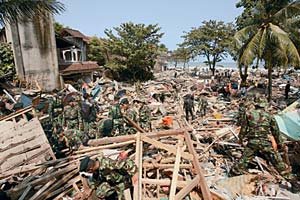 Photo by DIMAS ARDIAN / GETTY IMAGES via Time Asia Magazine
Photo by DIMAS ARDIAN / GETTY IMAGES via Time Asia MagazineRead the full article in the Asia Edition of TIME (July 26, 2006).
Almost 700 people were killed, nearly 1,000 injured and some 20,000 families left homeless by the tsunami that hit Java on July 17. But last month, the United Nations Education, Scientific and Cultural Organization (UNESCO) declared that an interim alert system was up and running. Why was the destruction so great?
TIME reports:
Patricio Bernal, executive secretary of UNESCO's Intergovernmental Oceanographic Committee, says the response to the Java tsunami actually represented a success for the interim warning system and in a sense, he's right. Just 17 minutes after the earthquake struck off the coast of Java, scientists at the Pacific Tsunami Warning Center (PTWC) in Hawaii crunched the seismological data and sent a bulletin to colleagues in Jakarta, warning of the possibility of a local tsunami for land within 100 km of the temblor's epicenter......."The initial system did work," says Bernal. "From then on, it is the responsibility of the Indonesian system."
About 20 minutes after the quake, the Indonesian Meteorology and Geophysics Agency's technical department for tsunamis received the e-mail bulletin from PTWC in Honolulu that included a warning about the risk of a local tsunami. Apparently, the
agency subsequently relayed text messages warning of the quake to about 400 Indonesian officials in disaster management, but there was little they could do: there were no alarm bells to ring on the beach, no emergency broadcasts to transmit over the radio or TV, no way to warn the people on the coast.
Clearly more needs to be done. I suggest that UNESCO does not have the resources to assist the poor Asia-Pacific nations to develop domestic tsunami warning systems, and that other donors must step up to fill the gap.
No comments:
Post a Comment